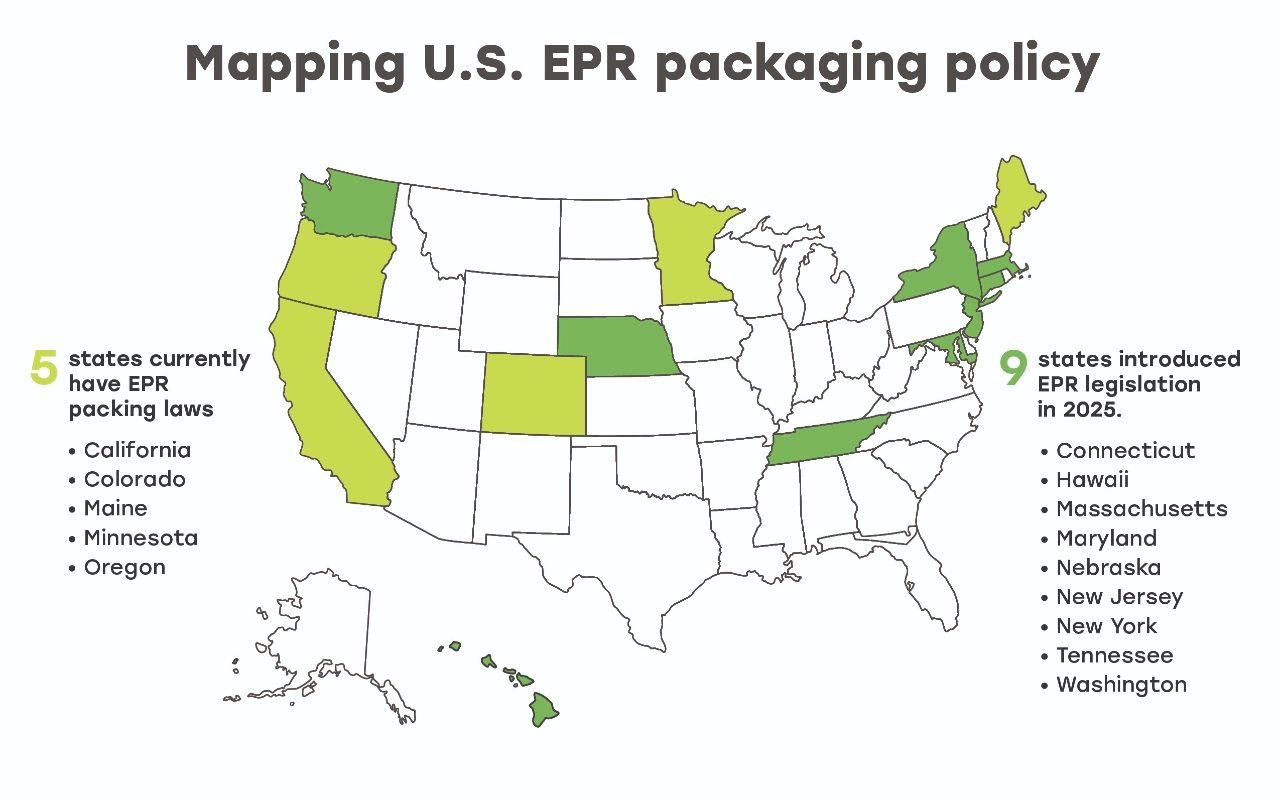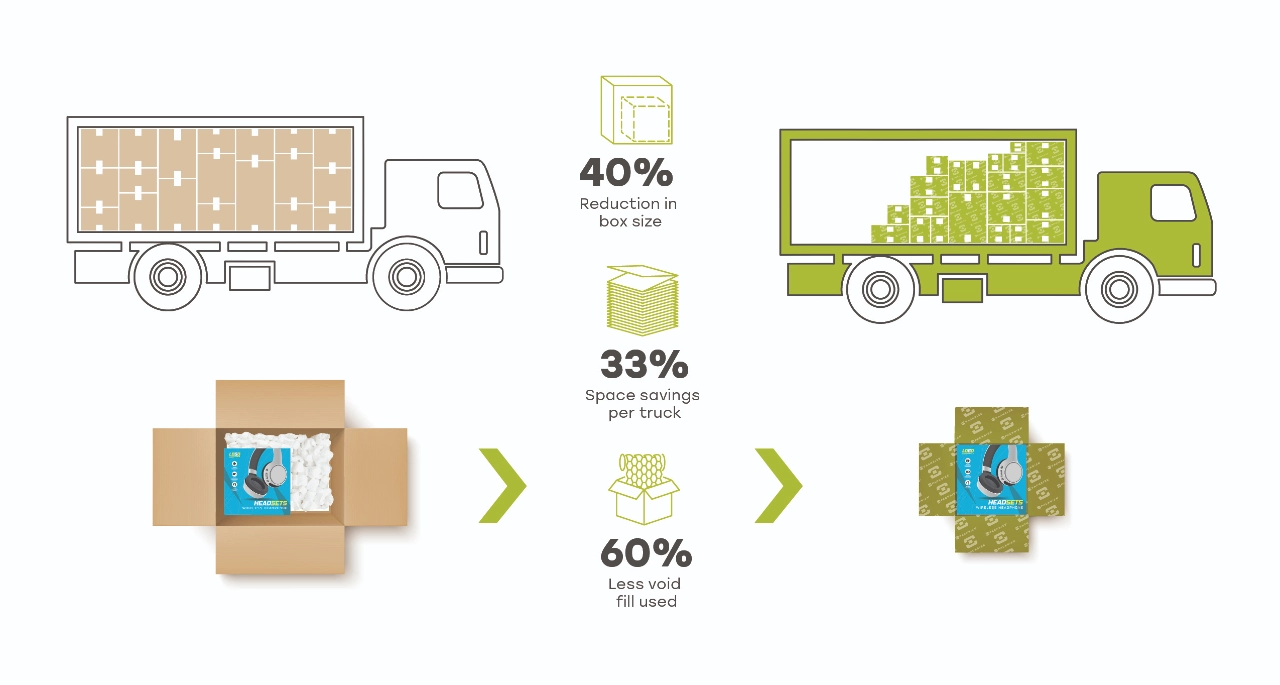The packaging landscape in the United States has taken a transformative turn with the recent enactment of Extended Producer Responsibility (EPR) laws in Maryland and Washington. As detailed in DLA Piper’s recent article, these states join a growing movement requiring producers to take greater responsibility for the lifecycle of their packaging materials - from design and distribution to collection and recycling. Currently there are five states that have some type of EPR regulation (as shown in the image below). Traction has been fast and furious with 10 states that applied last year and eight of those 10 moving towards regulation.

However, EPR does not need to be just a regulatory hurdle. Rather, it is a catalyst for packaging innovation and a movement to drive sustainability.
At Packsize, we see EPR as an opportunity to accelerate the shift toward right-sized, on-demand packaging - delivering solutions that help brands not only comply with new regulations but also lead the way in environmental stewardship.
EPR fundamentally changes the responsibilities of packaging producers, brands, and everyone along the supply chain. Under these new laws, companies are becoming more accountable for the environmental impact of their packaging, including recycling, waste management, and reporting.
While EPR creates opportunities for brands to differentiate themselves through sustainability, efficiency, and transparency, it also presents businesses with new challenges:
These challenges may feel overwhelming at a glance, but with the right partner and technology, companies can not only overcome these challenges to achieve compliance, but also experience reduced costs, increased throughput, and a more efficient packaging process flow.
One of the main goals of EPR is to reduce oversized packaging and unnecessary material waste. Traditional packaging methods often result in oversized boxes stuffed with wasteful void fillers, leading to higher costs and an increased carbon footprint.
Right-Sized Packaging On Demand flips the script. By tailoring each package to the dimensions of its contents, companies can:

For example, after implementing an automated right-sized packaging solution, Staples experienced a 20% reduction in corrugated, 70% reduction in void fill, and 40% reduction in box size. This not only improved their customer satisfaction, but also streamlined their packaging operation, leading to increased throughput and reduced operating costs overall.
EPR isn’t just about managing waste at the end of the packaging lifecycle - it’s about designing it out from the start. This means focusing on:
On Demand Packaging empowers brands to make the most of recyclable corrugated fanfold and removes airspace within a box, resulting in less void fill and smaller boxes. This ultimately allows more boxes to fit into a single truck, leading to less trucks on the road and lower carbon emissions.
EPR laws require robust data transparency, reporting, and traceability. Brands must know exactly how much material they’re using, how it’s being managed post-consumer, and how they are reducing waste.
“As EPR regulations evolve, brands must not only adopt sustainable packaging practices, but also demonstrate clear, data-driven accountability,” said Troy Rydman, Chief Information Security Officer at Packsize. “Right-Sized Packaging On Demand—backed by secure, transparent data insights - empowers companies to meet regulatory requirements, build customer trust, and drive continuous improvement in both sustainability and operational resilience.”
With the right technology in place, businesses can seamlessly track packaging material consumption, automate compliance reporting, and gain real-time visibility into their waste reduction efforts. By leveraging, secure, integrated data platforms, companies can confidently navigate regulatory demands while positioning themselves as leaders in responsible packaging innovation.
Meeting the demands of EPR is not a solo effort. Success requires strong partnerships between brands, packaging providers, and recyclers. At Packsize, we take a collaborative approach, working closely with our customers and industry partners to design solutions that meet both compliance goals and sustainability ambitions.
By fostering collaboration across the value chain, we help brands stay agile and ahead of evolving regulations.
EPR is just the beginning. As regulations and consumer demand for sustainable practices expand, packing processes will need to become:
Forward-thinking companies are already turning compliance into opportunity, with some taking steps to innovate, streamline, and create more sustainable packaging process flows even before regulations go into effect.
Right-Sized Packaging On Demand is more than just a way to comply with EPR regulations - it’s a blueprint for the future of sustainable packaging. By minimizing waste, maximizing efficiency, and embracing data-driven transparency, brands can meet regulatory requirements and unlock lasting value.
Let’s work together to turn compliance into a competitive advantage. Contact one of our Packsize representatives to learn how right-sized packaging can help your business thrive, and lead the way to a more sustainable future.
Contact us today for a personalised analysis of your intralogistic process.